Color gamut is a method of encoding colors and refers to the total number of colors that a display system can produce.
For customers, understanding the color gamut of a device can help determine its color performance ability, especially when choosing display devices such as LED screens, televisions, projectors, etc. Color gamut is an important reference indicator.
In display devices, common color gamut standards include sRGB, Adobe RGB, NTSC, etc. Different color gamut standards cover different color ranges. For example, sRGB is currently a widely used color gamut standard, followed by most web content and digital devices; Adobe RGB covers a wider range of green and blue colors, making it suitable for professional image design and printing fields; NTSC is an earlier color gamut standard.
In addition to color gamut, some screens also indicate their own color accuracy, which is commonly referred to as ΔE.
This document will provide a detailed introduction to color gamut, color space, and color accuracy.
¶ Concept of Color Gamut, Color Space, and Color Accuracy
¶ Color Gamut
When it comes to color gamut, we need to understand the CIE diagram (precisely CIE Chromaticity Diagram), as shown in Figure 1. The CIE diagram describes the color information of all visible light to the human eye, because the cone cells of the human eye cannot recognize all wavelengths of light. The visible light range is approximately from 380nm (purple) to 780nm (red), and the chromaticity coordinates (x-axis red, y-axis green) can uniquely determine the hue and saturation of a color.

Note:
- CIE images cannot present brightness information. Brightness information is represented by Y (uppercase Y), which is different from y in chromaticity coordinates and is represented in CIE XYZ space or CIE Lab * space.
- The diagonal lines on the CIE image are isotherms. Although different points on the same isochromatic temperature line have the same color temperature, their colors (x, y coordinates) are different. This indicates that even with the same color temperature, the hue and saturation of colors may vary.
- The curve on the CIE image is the "Planck trajectory", which runs through the middle of the CIE diagram and extends to the red area. The white point will appear on this curve, such as D65 (6500K); Additional explanation: D60, D63, D65: These numbers represent different white point color temperatures. Usually, D65 is the most common white point color temperature standard, representing a color temperature of 6500K, which is close to the color temperature of natural light (daylight). D65 is considered the most widely used white point color temperature standard internationally, particularly suitable for film projection and digital image processing.
¶ Color Space
When it comes to display technology and color reproduction, the CIE standard defines all color ranges perceivable by the human eye. Through mathematical transformation, the CIE chromaticity coordinates (x, y) can be converted to the RGB color model.
The RGB color space (such as sRGB, Adobe RGB) used by different devices (such as displays) can be mapped to the CIE chromaticity diagram, but displays typically can only display triangular regions composed of three RGB points. The core function of an LED controller is to convert digital signals in a computer into visible light, using different color formats such as RGB444 or YUV422, so that the screen can display specific colors. In order to ensure color consistency between different devices and applications, different industries have developed their own color standards. These standards define specific areas within the CIE color coverage range, commonly referred to as color spaces such as Rec.2020 and DCI-P3.
Ideally, a screen should be able to reproduce all colors in the CIE chromaticity diagram, but currently, due to technological limitations, the screen can only display colors formed by mixing the three primary colors of red, green, and blue. Therefore, the color range that the screen can represent is limited to the extreme combination of these three colors, forming a triangular area, which is the color space of the screen, as shown in Figure 2.

As shown in Figure 3, newly emerged concepts such as RGBW, RGBCW, and 6P color aim to expand the CIE color range by increasing the number of base colors, thereby broadening the screen's color gamut.

If the factory cabinets display 95% DCI-P3, it means that the cabinet can display 95% of the DCI-P3 color space. This is the original color gamut of the cabinet collected during the NCP making process, and the ratio is obtained based on the standard color gamut.
When comparing screen color gamut, it is necessary to pay attention to the standards after the numbers, rather than just comparing the front numbers. For example, a 100% sRGB screen may appear to have a wider color space coverage compared to a 99% DCI-P3 screen, but in reality, 100% sRGB can only cover 79.6% of the DCI-P3 color gamut, while a 95% DCI-P3 color gamut is much wider than a 100% sRGB color gamut. Many users use computer monitors as the echo display for LED screens and find that there is a significant color difference, which is also due to the large display differences of the same input source in different color spaces.
When the color space of the input source is not consistent with the screen, colors that exceed the screen color space will be forcibly displayed according to a certain reflection, which means that the colors seen on the screen are no longer their actual colors, and the colors perceived by the human eye will be distorted. So it is particularly important to make the color space of the display screen and input source consistent. Therefore, in scenes with high requirements for image quality and color, the control system must have color management functions.
¶ Color Accuracy
In the LED industry, color accuracy refers to the precision of LED color display. For example, when you expect to display blue, the screen does display blue instead of cyan or other inaccurate colors.
The main parameter for measuring color accuracy is ΔE, which describes the degree of color difference between the displayed color and the target color. The smaller the ΔE value, the closer the displayed color is to the target color, and the higher the color accuracy. Screens with ΔE values between 1.5 and 3 have very good color accuracy, while screens with ΔE values less than or equal to 1.5 have excellent color accuracy.
|
Parameters of |
Correlation with color accuracy |
|
White Point |
Inaccurate adjustment of the white point may cause the white color deviation in the display, affecting overall color accuracy. |
|
Color Temperature |
Incorrect setting of color temperature can cause the displayed color to deviate from the expected one, affecting color authenticity and accuracy. |
|
Color Gamut |
Colors displayed within the color gamut typically maintain color accuracy more accurately, while colors outside the gamut may result in color compression or inaccuracy. |
¶ Color Space Management in VMP
The color space management currently supported within VMP is divided into ITU-R (the International Telecommunication Union) standards and DCI (Digital Cinema Initiatives) standards; It also supports the original color gamut and custom color gamut of the screen.
ITU-R standards include Rec.709 and Rec.2020, also known as BT.709 and BT.2020
The DCI-P3 standard includes: DCI-P3 (D60, D65 share the same color gamut while with different white points)
By clicking on CIE, different color gamut displays are presented to meet customers' needs for color space range. VMP also supports modifying (x, y) to achieve custom color gamut, as shown in Figure 4.
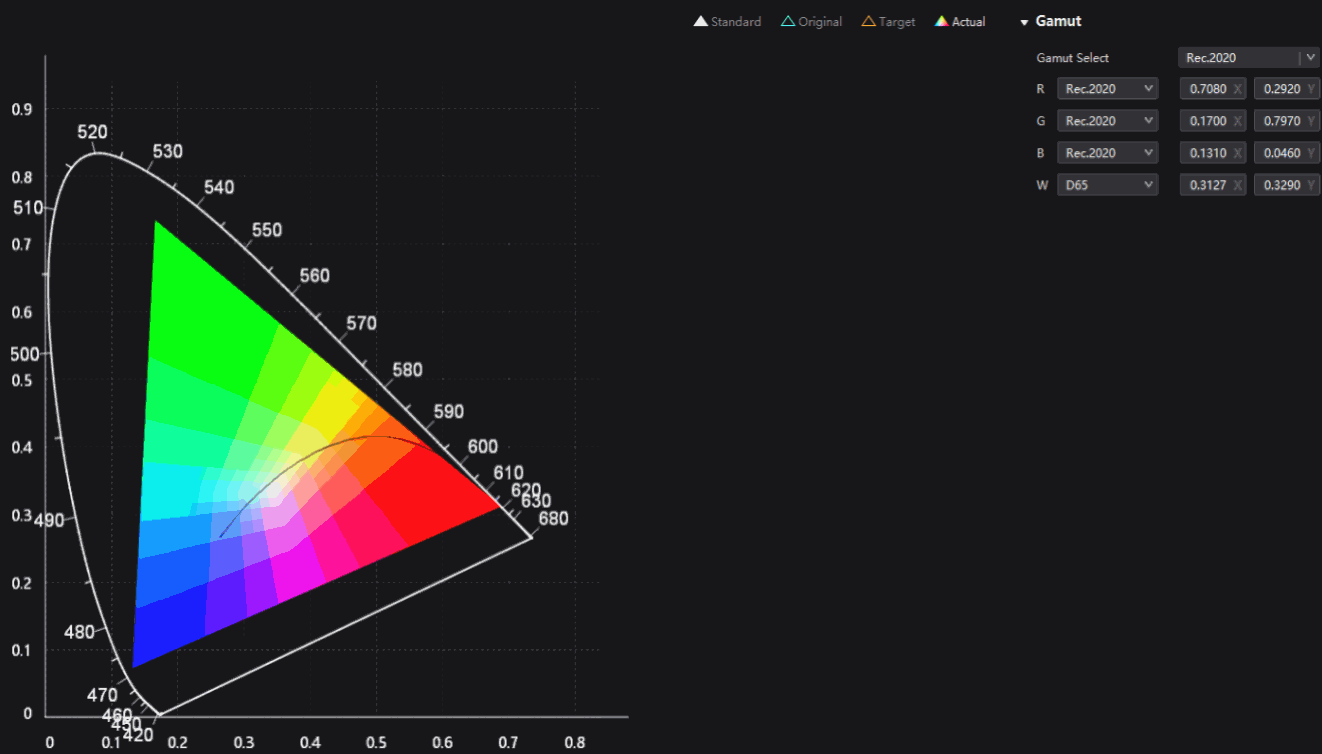

¶ Color Space Applications
When doing cabinets calibration in the Cabinet Tool, the coordinates of the original color on CIE will be collected first, as shown in Figure 6. The coordinates of other color spaces will be automatically calculated after the collection of the original color space is completed. The original color space refers to the range of colors that a device can display before calibration or adjustment.
The size of the original color space has a significant impact on the display effect. The larger the coverage area of the color space, the wider the color range that the device can display, and the color expression may also be richer and more accurate.
Different display devices have different original color spaces, for example, some high-end screens may have a wider color space, able to present more color details and brighter colors. And the original color space of some common screens may be relatively small.

¶ Rec.709 Color Space
Rec.709 is the international standard color space for high-definition televisions.
Rec.709 color space has been widely used in fields such as broadcasting and television, Blu ray discs, etc. for a long time in the past. The development of technology may lead to the adoption of broader color space standards, such as DCI-P3 or Rec.2020, for scenes that require higher color expression, such as film production and high-end display devices.

¶ Rec.2020 Color Space
Rec.2020 is a color space standard developed by the International Telecommunication Union (ITU). It aims to provide a wider color range and higher color accuracy for fields such as high-definition television and digital movies.
The coverage of Rec.2020 color space on the CIE 1931 chromaticity diagram is wider than other common color space standards such as sRGB and Rec.709. This means it can display more colors, especially in the green and red areas. In practical applications, Rec.2020 color space is commonly used for professional film and television production, post-processing, and high-end display devices to provide more realistic and rich color representation. Generally, Rec.709 or sRGB color space display devices are already able to meet most customers‘ daily needs.

¶ Rec.601-525 Color Space
The Rec.601-525 color space is specified in the ITU-R BT.601 standard, also known as the ITU-R BT.601 color space or Rec.601 color space. This color space is mainly used for standard definition television (SDTV) systems, and its color space is based on the YCbCr color model, where Y represents brightness, and Cb and Cr represent blue chromaticity and red chromaticity respectively. The coverage of Rec.601-525 color space on the CIE 1931 chromaticity diagram is relatively small, and compared with other broader color space standards such as Rec.709 and Rec.2020, it can display a limited number and range of colors.

¶ Rec.601-625 Color Space
The Rec.601-625 color space is specified in the ITU-R BT.601 standard, mainly used in standard definition television (SDTV) systems. In practical applications, the coverage range of the Rec.601-625 color space is relatively small. Compared with other broader color space standards such as Rec.709 and Rec.2020, it can display a limited number and range of colors. However, for some specific application scenarios, such as traditional analog television broadcasting, early digital television production, and some specific video surveillance systems, the Rec.601-625 color space still play an important role.

¶ DCI-P3 Color Space
DCI-P3 color space is a color space standard applied to digital movies, which has a relatively large color space range and can present richer, brighter, and more accurate colors.
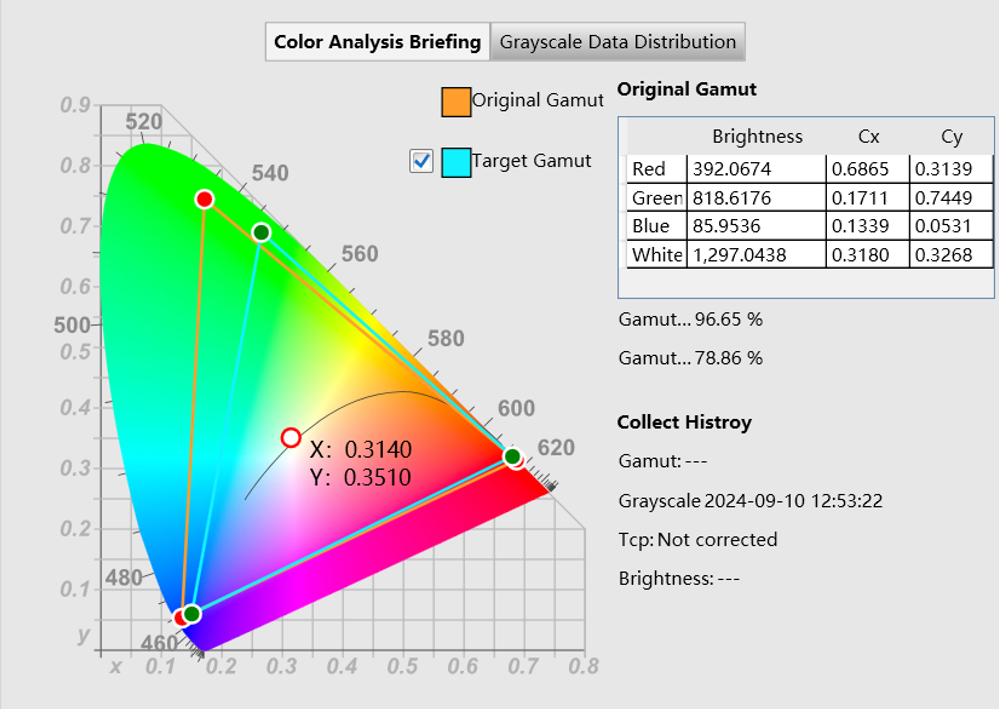
¶ NTSC Color Space
The NTSC color space refers to the sum of colors under the NTSC standard. The characteristics of the NTSC color space are bright colors and high saturation, making it suitable for applications in film and television post production, gaming, and other fields.
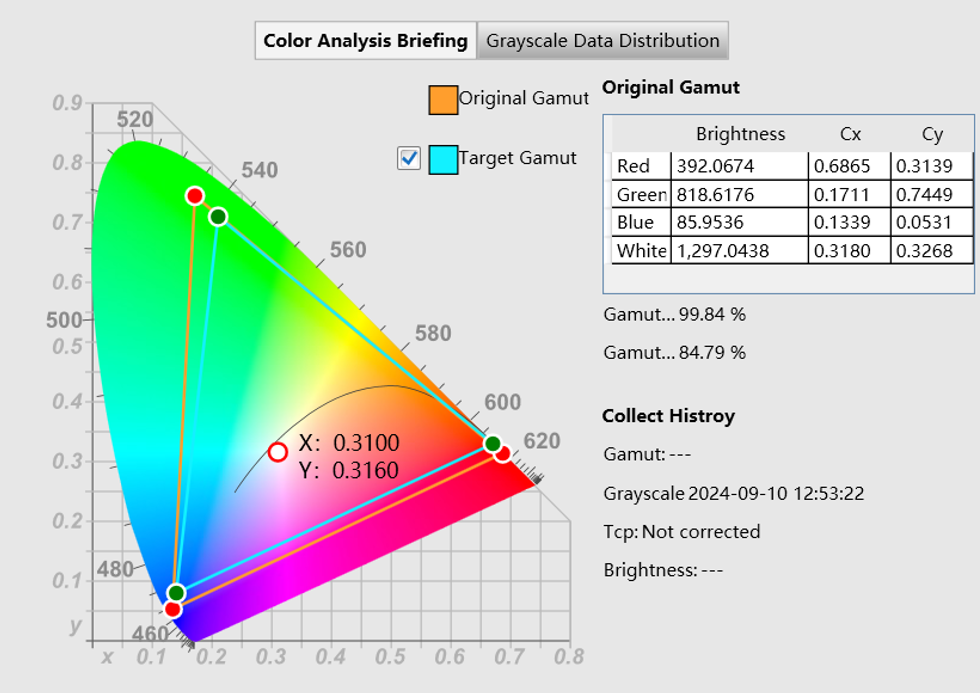
¶ PAL Color Space
The color space standard of PAL system is similar to that of NTSC system, and its color space range is also limited to some extent. The color space range of PAL standard is approximately 70% of that of NTSC standard. The range of U and V signals in PAL system is relatively small, so its color space range is also relatively small.
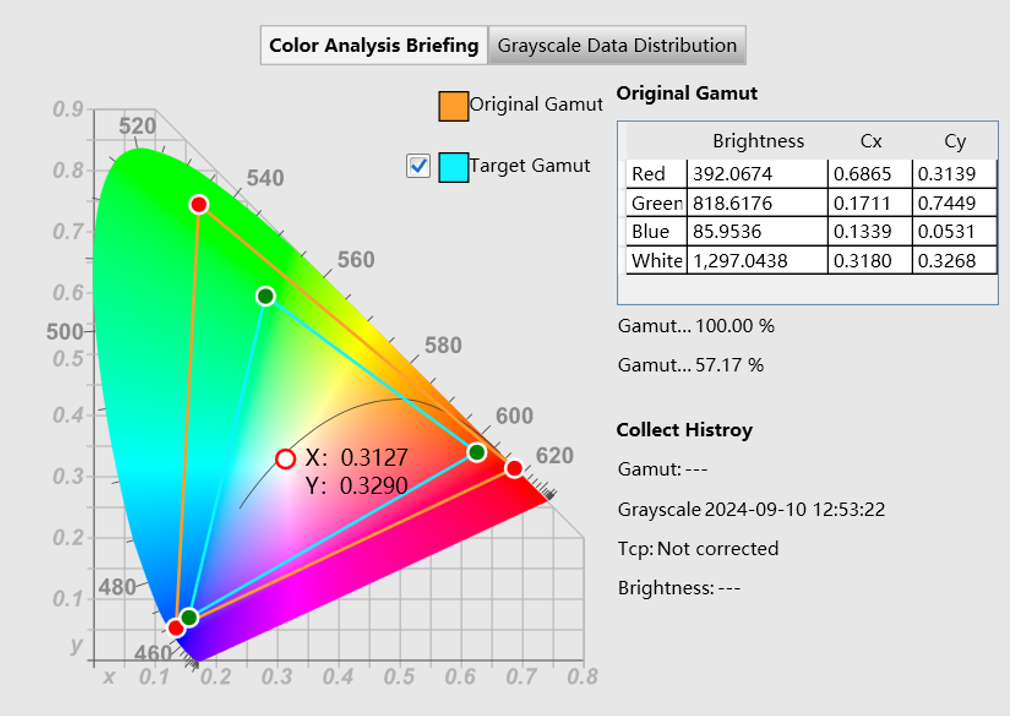
¶ Adobe RGB Color Space
The Adobe RGB color space is a color space standard introduced by Adobe company, which has a wider color range than sRGB, especially in the green and blue areas where it performs better. This makes it of significant application value in professional fields such as photography, printing, and design. The Adobe RGB color space can cover more visible colors, providing more accurate and vivid color effects for applications that require precise color reproduction and richer color representation, such as post-processing of high-end photography works and production of professional prints. The coordinate values of Adobe RGB color space may vary depending on specific standards and devices.

¶ sRGB Color Space
The sRGB color space covers a relatively small range of colors, and most online content and common digital images are created and displayed based on the sRGB color space.
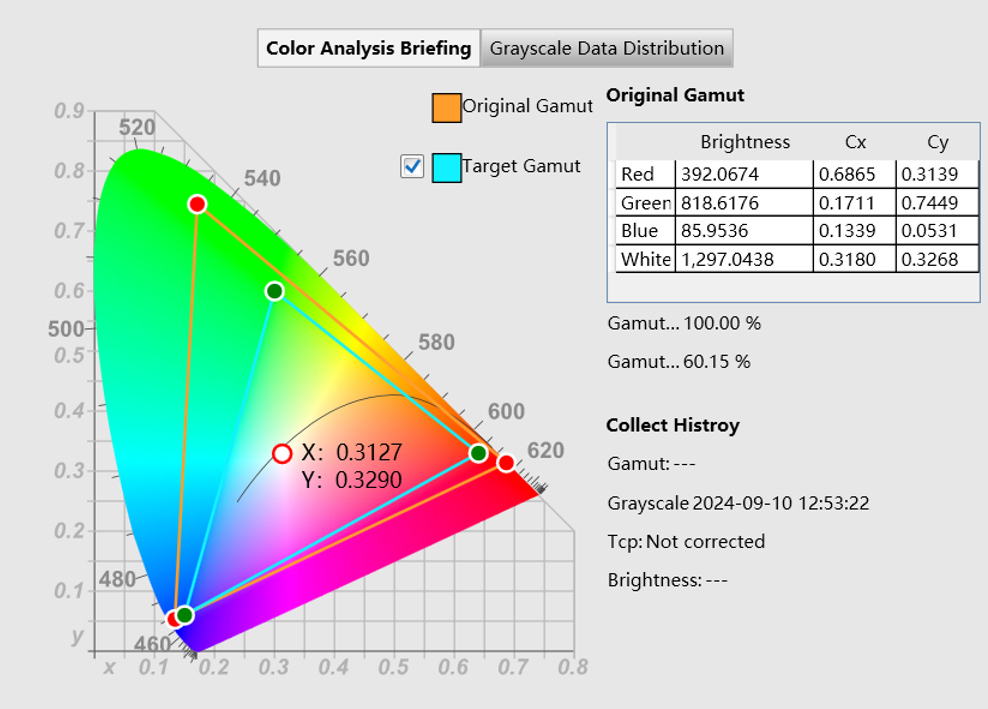
¶ Additional color gamut introduction
In addition to above mentioned physical color gamut related to the device, the transmission and production processes also use some device independent color gamut that is larger than the visible light range to the human eye, such as XYZ and ACES.
¶ XYZ and ACES
NTSC, Adobe RGB, BT.709/sRGB, DCI-P3, and BT.2020 are all physical color gamut, and their display color range depends on the device. These display color gamuts are smaller than the visible light color gamut of the human eye, and it is impossible to produce colors beyond it in the space of the display color gamut.
In the transmission and production process, some device independent color gamut that is larger than the visible light range of the human eye is used, which are typically XYZ and ACES color gamut, as shown in Figures 7 and 8. The space of XYZ and ACES is larger than the visible color range of the human eye, and they can produce and transmit colors beyond the display color gamut without losing color information in the transmission and production process.
- XYZ is the DCDM (Digital Cinema Distribution Master) and DCP (Distribution Copy) transmission/production color gamut defined in the DCI/SMPTE 428-1 file, using an idealized Cartesian coordinate system with the largest coverage area. Compared with BT.709/2020, XYZ has a larger color vector difference and lower spatial resource utilization.
- ACES (Academy Color Encoding System) is a production color gamut defined by the Academy of Motion Picture Arts and Sciences in the United States. It has a smaller coverage range than XYZ color gamut but larger than the visible light color range of the human eye. Its color vector difference is smaller than BT.709/2020, and its spatial resource utilization rate is higher than XYZ. It has been recognized by mainstream equipment manufacturers.


Similar to gamma matching, the shooting/production color gamut must be consistent with the display color gamut in order to ensure the color reproduction of the photographed subject.. When the shooting/production color gamut is different from the display color gamut, color hue or saturation distortion may occur. When the display color gamut is smaller than the shooting color gamut, the direct manifestation is that the displayed color saturation is lower than the actual scene color saturation. When the display color gamut is larger than the shooting color gamut, the displayed color saturation is higher than the actual scene color saturation. Only when the shooting and display color gamut are the same, the displayed color saturation will be the same as the actual scene color saturation, as shown in Figure 9. Due to the different positions of the base color points in different color gamuts, the same color has different saturation and hues in different color gamuts. In fact, color gamut is equivalent to a ruler for measurement. Only when using the same ruler to measure color during shooting and display can the same value be obtained. When measuring the same color with different rulers, the value obtained is different, as shown in Figure 10.


We consistently enhance and refine the content of our Wiki articles.
If you find any mistakes or errors, please contact us.
Your continuous feedback and support will help us further improve our products and content.